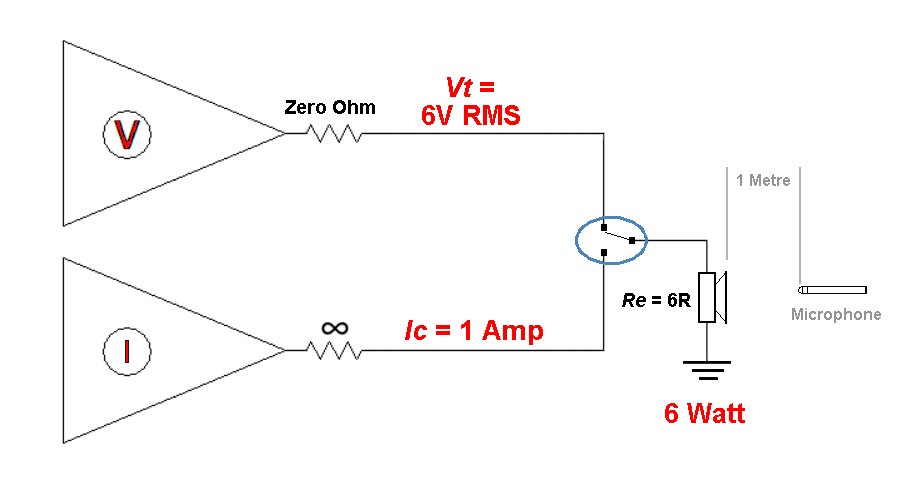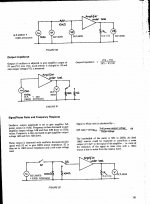what are we doing in this thread? being fed crap by Joe is tiring as it is boring...
merge this with the blowtorch thread has been hijacked, still no cigar....
merge this with the blowtorch thread has been hijacked, still no cigar....
I hope Joe isn't too disappointed to find he's not been ripped to shreds when he returns 😉
No, I am surprisingly pleased. I don't find it pleasurable to be "ripped to threads" as I am a sensitive guy. 😀
No, some good comments and substantive. Does voltage have the ability to 'control' or does it only have the potential to initiate current and that is not the same as control?
But to prove this yay or nay, this comes down to distortion, and measuring it.
Questions to be asked and answered:
This is where the challenge comes in. Pavel has made a good start even if I don't think his most important conclusion is correct. The tweeter or driver does not have lower distortion under current drive, it just that voltage drive makes the distortion worse because the amplifier joins in and just makes it worse. The tweeter will always have its native distortion that can only be improved by being designed as a better driver.
So this is an argument for BETTER drivers with lower distortion.
The idea that we can lower distortion by using current drive (in effect, that is what the current drive camp seems to think) does not stack up. Using current drive to get the distortion down? That is not what is happening. It is just that the current amplifier is immune to the "back-EMF impedance" of the amplifier and so does not add distortion. That is how I see the mechanism.
So this is not about current drive versus voltage drive, it is about distortion and what we can do about it.
Does the output transformer also mean we get amplifiers with a better (lower?) current distortion profiles, particularly IMD, compared to a common but good SS amp.
Is that why some of us prefer tubes?
What if Pavel had done the same test with a tube amp with output transformer. Would we have seen a result with IMD lower and getting closer to currrent drive IMD? That would clinch the argument, but he didn't do that.
I believe that the output transformer, normally viewed as a step-up device, in current terms is really a step-up transformer and in effect, the driver looking back at the amplifier does not see a step-up transformer, it sees a step-down transformer that has become part of a current delivery system.
I am simply asking questions and seeking answers.
I don't have all the answers yet, but I sure have some of them.
Cheers, Joe
You seem to answer some of your own questions in this post.I am simply asking questions and seeking answers.
Have you seen the Gedlee metric thread?

Dear Joe,
do you even understand your drawing?
0 ohms with 6 volts output is indeed 6 volts into a 6R load,
but infinity ohms into 1A, to a 6 ohm load is infinite volts, have you invented your own mathematics now?
even if you were to change infinite, to "very high impedance", the answer will still be very high voltage.....
if you do not realize the folly in what you post, then you will be continually be challenged by people who knew better than you..
George Simon Ohm can never be disrespected....nor discarded...
falcis in unum, falces in omnibus....
Last edited:
what are we doing in this thread? being fed crap by Joe is tiring as it is boring...
merge this with the blowtorch thread has been hijacked, still no cigar....
I find there is a lot coming out of this> I don’t see Joe feeding us crap. He has said nothing inconsistent with what i know about all of this. He has done some interesting speculation, and he has been clear that much of what he has said is a thesis.
I have seen a lot of crap thrown his way, but i see little to practically support the arguments made against what Joe has to say.
BTW Tony, i asked this of you in the back room, i miss you, but how many ACAs have you built in your amp camps? Everyone of those guys should know about the things we are talking about wrt interaction of highish amplifier output impedance and speaker impedance.
Joe. You are quoting single number distortion, we all know that so much information is lost when the spectrum is collapsed that it becomes next to useless. Do you have spectrums?
dave
Dave,
i conducted teach ins and build outs and to date about 70 channels of ACA have been built, and more is coming in the future..
you can not see crap when you are in a tag team with Joe...it is easy to see his crap if you open your eyes..
i conducted teach ins and build outs and to date about 70 channels of ACA have been built, and more is coming in the future..
you can not see crap when you are in a tag team with Joe...it is easy to see his crap if you open your eyes..
You seem to answer some of your own questions in this post.
Have you seen the Gedlee metric thread?
You mean Earl Geddes.
Yes, we have had online discussions, but he is basically not interested.
He is fully married to the voltage theory, that there is an equivalence with current (which I believe I have proved not to be quite true). It goes like this, double the voltage and you will double the current, then don't ask any questions. "Joe, it is a waste of time" he said, "but if you want to pursue it, that is up to you."
He is basically saying that the driver is a perfect I/V converter. But doubling the current via doubling the voltage tells us very little about the behaviour of the driver. Changes in current can be induced by that behaviour even if the voltage of the amplifier does not. Those changes can be rapid signatures that indicate distortion, particularly IMD, I suspect (and already Pavel has indicated this by his measurement).
I am still on good terms with Earl. There was never anything harsh said.
His work on Waveguides and Higher Order Modes is a landmark IMO. I am definitely a fan of Waveguides. But some use them to lower the crossover point (and that is an advantage), but I use Waveguides to lower distortion.
Yes, I am a tube guy who is into lower distortion, how about that!
Cheers, Joe
0 ohms with 6 volts output is indeed 6 volts into a 6R load,
Source impedance is zero, the amplifier is outputing 6V (and a cuurnt based on the R).
but infinity ohms into 1A, to a 6 ohm load is infinite volts, have you invented your own mathematics now?
Source impedance is infinite, the amp is outputting 1A (with a volatge based on R). ie 1 A into 6Ω.
Now qirg a speaker the 1st case has to use the (usually) reactive speaker as the IV converter. No conversion needed in the 2nd case.
You really need to wade thru ESA’s math i think it would turn on a loyt of lights.
dave
you can not see crap when you are in a tag team with Joe...it is easy to see his crap if you open your eyes..
We are not a tag team. But i will admit that i encouraged him on this journey.
We did share a guru (joe a lot closer to him than me).
dave
Source impedance is zero, the amplifier is outputing 6V (and a cuurnt based on the R).
Source impedance is infinite, the amp is outputting 1A (with a volatge based on R). ie 1 A into 6Ω.
Now qirg a speaker the 1st case has to use the (usually) reactive speaker as the IV converter. No conversion needed in the 2nd case.
You really need to wade thru ESA’s math i think it would turn on a loyt of lights.
dave
what i am saying is that you need an amp with an infinite voltage in order to do that, sorry if i was not clear..
because each thevenin circuit has an equivalent norton and vice versa..
Last edited:
Just thinking that if you didn’t want to buy ESA’s book, you could probably work thru the equations yourself.
dave
dave
We are not a tag team. But i will admit that i encouraged him on this journey.
We did share a guru (joe a lot closer to him than me).
dave
why don't he get a paid for forum? other members with solid ethics did that the moment they were in to commercial ventures...
in the vendor's forum, i will totaly ignore him, but never in these technical threads...
I can appreciate that 😉I am a tube guy who is into lower distortion
Well for one he is not vending here.
dave
not directly no....
I can appreciate that 😉
in a tube amp, low distortion numbers look good on paper....
but there are other important considerations more than distortions alone..
single-ended tube amps did not have ppm distortions but many liked them...
Nelson Pass amps did not have ppm distortion numbers, but actual listening
confirmed that they indeed sound good...
can one approximate the interaction by simply viewing an amplifier with significant output impedance relative to the speaker system's nominal impedance as a frequency dependent voltage divider?
At resonant peaks and into higher frequencies where a speaker may have higher impedance, the divider attenuation will be much less than the low spots on the curve.
Seems like is should behave that way when a constant voltage amplifier has a resistor put in series with it and the speaker system,
Below is a quick sim of 12LTA in an open back box at Rg=0.4, Eg = 2.93 vs 22 ohms Rg, and 11 volts drive at the resistor to get similar output

At resonant peaks and into higher frequencies where a speaker may have higher impedance, the divider attenuation will be much less than the low spots on the curve.
Seems like is should behave that way when a constant voltage amplifier has a resistor put in series with it and the speaker system,
Below is a quick sim of 12LTA in an open back box at Rg=0.4, Eg = 2.93 vs 22 ohms Rg, and 11 volts drive at the resistor to get similar output

🙄It seems somebody here does not know what an output impedance is?
He doesn't understand what a current source is and then presumes to lecture me?
Nobody told me that there would be days like these. Stange days indeed!
He doesn't understand what a current source is and then presumes to lecture me?
Nobody told me that there would be days like these. Stange days indeed!
Last edited:
🙄It seems somebody here does not know what an output impedance is?
He doesn't understand what a current source is and then presumes to lecture me?
Nobody told me that there would be days like these. Stange days indeed!
how can you tell?
Attachments
Last edited:
- Status
- Not open for further replies.
- Home
- Amplifiers
- Tubes / Valves
- Do tubes actually sound like anything?
